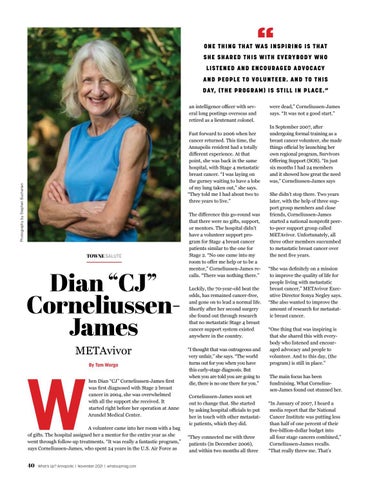ONE THING THAT WAS INSPIRING IS THAT SHE SHARED THIS WITH EVERYBODY WHO LISTENED AND ENCOURAGED ADVOCACY AND PEOPLE TO VOLUNTEER. AND TO THIS DAY, (THE PROGRAM) IS STILL IN PLACE.” an intelligence officer with several long postings overseas and retired as a lieutenant colonel.
Photography by Stephen Buchanan
Fast forward to 2006 when her cancer returned. This time, the Annapolis resident had a totally different experience. At that point, she was back in the same hospital, with Stage 4 metastatic breast cancer. “I was laying on the gurney waiting to have a lobe of my lung taken out,” she says. “They told me I had about two to three years to live.”
TOWNE SALUTE
Dian “CJ” CorneliussenJames METAvivor
W
By Tom Worgo hen Dian “CJ” Corneliussen-James first was first diagnosed with Stage 2 breast cancer in 2004, she was overwhelmed with all the support she received. It started right before her operation at Anne Arundel Medical Center.
A volunteer came into her room with a bag of gifts. The hospital assigned her a mentor for the entire year as she went through follow-up treatments. “It was really a fantastic program,” says Corneliussen-James, who spent 24 years in the U.S. Air Force as
40
What’s Up? Annapolis | November 2021 | whatsupmag.com
The difference this go-round was that there were no gifts, support, or mentors. The hospital didn’t have a volunteer support program for Stage 4 breast cancer patients similar to the one for Stage 2. “No one came into my room to offer me help or to be a mentor,” Corneliussen-James recalls. “There was nothing there.” Luckily, the 70-year-old beat the odds, has remained cancer-free, and gone on to lead a normal life. Shortly after her second surgery she found out through research that no metastatic Stage 4 breast cancer support system existed anywhere in the country. “I thought that was outrageous and very unfair,” she says. “The world turns out for you when you have this early-stage diagnosis. But when you are told you are going to die, there is no one there for you.” Corneliussen-James soon set out to change that. She started by asking hospital officials to put her in touch with other metastatic patients, which they did. “They connected me with three patients (in December 2006), and within two months all three
were dead,” Corneliussen-James says. “It was not a good start.” In September 2007, after undergoing formal training as a breast cancer volunteer, she made things official by launching her own regional program, Survivors Offering Support (SOS). “In just six months I had 24 members and it showed how great the need was,” Corneliussen-James says She didn’t stop there. Two years later, with the help of three support group members and close friends, Corneliussen-James started a national nonprofit peerto-peer support group called METAvivor. Unfortunately, all three other members succumbed to metastatic breast cancer over the next five years. “She was definitely on a mission to improve the quality of life for people living with metastatic breast cancer,” METAvivor Executive Director Sonya Negley says. “She also wanted to improve the amount of research for metastatic breast cancer. “One thing that was inspiring is that she shared this with everybody who listened and encouraged advocacy and people to volunteer. And to this day, (the program) is still in place.” The main focus has been fundraising. What Corneliussen-James found out stunned her. “In January of 2007, I heard a media report that the National Cancer Institute was putting less than half of one percent of their five-billion-dollar budget into all four stage cancers combined,” Corneliussen-James recalls. “That really threw me. That’s
























